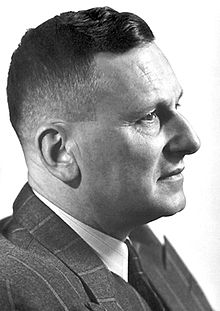Paul Hermann Müller
Paul Hermann Müller (born January 12, 1899 in Olten / Solothurn ; † October 13, 1965 in Basel ) was a Swiss chemist and winner of the Nobel Prize for Medicine .
Life
Paul Hermann Müller's father was employed as a merchant for Swiss Railways . He spent his early childhood in Lenzburg ( Canton Aargau ) before the family moved to Basel. Here Paul Hermann Müller attended the Free Evangelical Primary School , later the Lower and Upper Realschule . Because of bad grades, he left the upper secondary school in 1916 and worked for two years as a laboratory assistant at the Dreyfuss & Cie. and the Lonza company . From 1918 to 1919 he attended secondary school again to take the high school diploma . From the winter semester of 1919/1920 on, he studied chemistry as a major, with physics and botany as a minor at the University of Basel . Müller received his doctorate there in 1925 under Friedrich Fichter (1869–1952) with summa cum laude on chemical and electrochemical oxidation of as.m-xylidine and its mono- and di-methyl derivative .
On May 25, 1925, Paul Hermann Müller began working as a research chemist for JR Geigy AG in Basel. Here he first dealt with vegetable and synthetic dyes , then with synthetic tannins . It was not until 1935 that Geigy started looking for textile and pesticides . Müller developed a mercury-free seed dressing . As a member of a working group of Geigy research director Paul Läuger he realized in autumn 1939 , the insecticidal effect of the 1874 first synthesized Dichlorphenyltrichloräthens (DDT) .
In 1948 Müller received the Nobel Prize for Medicine "for discovering the strong effects of DDT as a contact poison against several arthropods ( arthropods )" . It was the first time that this award was given to a non-medical practitioner.
Müller worked for Geigy until his retirement in 1961, from 1946 as Vice Director, from 1959 as Deputy Director.
Paul Hermann Müller had been married to Friedel Rüegsegger since 1927, and the marriage resulted in two sons and a daughter.
literature
- August W. Holldorf: Müller, Paul. In: New German Biography (NDB). Volume 18, Duncker & Humblot, Berlin 1997, ISBN 3-428-00199-0 , p. 466 f. ( Digitized version ).
Web links
- Information from the Nobel Foundation on the award ceremony in 1948 to Paul Hermann Müller (English) and a banquet speech (German)
- Literature by and about Paul Hermann Müller in the catalog of the German National Library
Individual evidence
- ^ Biographical data, publications and academic family tree of Paul Hermann Müller at academictree.org, accessed on January 4, 2019.
- ↑ a b Christian Simon : DDT - cultural history of a chemical compound . Christoph Merian Verlag, Basel, 1999, ISBN 3-85616-114-7
- ↑ Lukas Straumann: Useful pests . Chronos Verlag, Zurich, 2005, ISBN 3-0340-0695-0
| personal data | |
|---|---|
| SURNAME | Müller, Paul Hermann |
| BRIEF DESCRIPTION | Swiss chemist, Nobel Prize in Medicine 1948 |
| DATE OF BIRTH | January 12, 1899 |
| PLACE OF BIRTH | Olten , Solothurn |
| DATE OF DEATH | October 13, 1965 |
| Place of death | Basel |
